Yassine Benajiba
MemInsight: Autonomous Memory Augmentation for LLM Agents
Mar 27, 2025Abstract:Large language model (LLM) agents have evolved to intelligently process information, make decisions, and interact with users or tools. A key capability is the integration of long-term memory capabilities, enabling these agents to draw upon historical interactions and knowledge. However, the growing memory size and need for semantic structuring pose significant challenges. In this work, we propose an autonomous memory augmentation approach, MemInsight, to enhance semantic data representation and retrieval mechanisms. By leveraging autonomous augmentation to historical interactions, LLM agents are shown to deliver more accurate and contextualized responses. We empirically validate the efficacy of our proposed approach in three task scenarios; conversational recommendation, question answering and event summarization. On the LLM-REDIAL dataset, MemInsight boosts persuasiveness of recommendations by up to 14%. Moreover, it outperforms a RAG baseline by 34% in recall for LoCoMo retrieval. Our empirical results show the potential of MemInsight to enhance the contextual performance of LLM agents across multiple tasks.
A Study on Leveraging Search and Self-Feedback for Agent Reasoning
Feb 17, 2025Abstract:Recent works have demonstrated that incorporating search during inference can significantly improve reasoning capabilities of language agents. Some approaches may make use of the ground truth or rely on model's own generated feedback. The search algorithm uses this feedback to then produce values that will update its criterion for exploring and exploiting various reasoning paths. In this study, we investigate how search and model's self-feedback can be leveraged for reasoning tasks. First, we explore differences in ground-truth feedback and self-feedback during search for math reasoning. Second, we observe limitations in applying search techniques to more complex tasks like tool-calling and design domain-specific approaches to address these gaps. Our experiments reveal challenges related to generalization when solely relying on self-feedback during search. For search to work effectively, either access to the ground-truth is needed or feedback mechanisms need to be carefully designed for the specific task.
Self-supervised Analogical Learning using Language Models
Feb 03, 2025Abstract:Large language models have been shown to suffer from reasoning inconsistency issues. That is, they fail more in situations unfamiliar to the training data, even though exact or very similar reasoning paths exist in more common cases that they can successfully solve. Such observations motivate us to propose methods that encourage models to understand the high-level and abstract reasoning processes during training instead of only the final answer. This way, models can transfer the exact solution to similar cases, regardless of their relevance to the pre-training data distribution. In this work, we propose SAL, a self-supervised analogical learning framework. SAL mimics the human analogy process and trains models to explicitly transfer high-quality symbolic solutions from cases that they know how to solve to other rare cases in which they tend to fail more. We show that the resulting models after SAL learning outperform base language models on a wide range of reasoning benchmarks, such as StrategyQA, GSM8K, and HotpotQA, by 2% to 20%. At the same time, we show that our model is more generalizable and controllable through analytical studies.
TReMu: Towards Neuro-Symbolic Temporal Reasoning for LLM-Agents with Memory in Multi-Session Dialogues
Feb 03, 2025Abstract:Temporal reasoning in multi-session dialogues presents a significant challenge which has been under-studied in previous temporal reasoning benchmarks. To bridge this gap, we propose a new evaluation task for temporal reasoning in multi-session dialogues and introduce an approach to construct a new benchmark by augmenting dialogues from LoCoMo and creating multi-choice QAs. Furthermore, we present TReMu, a new framework aimed at enhancing the temporal reasoning capabilities of LLM-agents in this context. Specifically, the framework employs \textit{time-aware memorization} through timeline summarization, generating retrievable memory by summarizing events in each dialogue session with their inferred dates. Additionally, we integrate \textit{neuro-symbolic temporal reasoning}, where LLMs generate Python code to perform temporal calculations and select answers. Experimental evaluations on popular LLMs demonstrate that our benchmark is challenging, and the proposed framework significantly improves temporal reasoning performance compared to baseline methods, raising from 29.83 on GPT-4o via standard prompting to 77.67 via our approach and highlighting its effectiveness in addressing temporal reasoning in multi-session dialogues.
DiverseAgentEntropy: Quantifying Black-Box LLM Uncertainty through Diverse Perspectives and Multi-Agent Interaction
Dec 12, 2024



Abstract:Quantifying the uncertainty in the factual parametric knowledge of Large Language Models (LLMs), especially in a black-box setting, poses a significant challenge. Existing methods, which gauge a model's uncertainty through evaluating self-consistency in responses to the original query, do not always capture true uncertainty. Models might respond consistently to the origin query with a wrong answer, yet respond correctly to varied questions from different perspectives about the same query, and vice versa. In this paper, we propose a novel method, DiverseAgentEntropy, for evaluating a model's uncertainty using multi-agent interaction under the assumption that if a model is certain, it should consistently recall the answer to the original query across a diverse collection of questions about the same original query. We further implement an abstention policy to withhold responses when uncertainty is high. Our method offers a more accurate prediction of the model's reliability and further detects hallucinations, outperforming other self-consistency-based methods. Additionally, it demonstrates that existing models often fail to consistently retrieve the correct answer to the same query under diverse varied questions even when knowing the correct answer.
Inference time LLM alignment in single and multidomain preference spectrum
Oct 24, 2024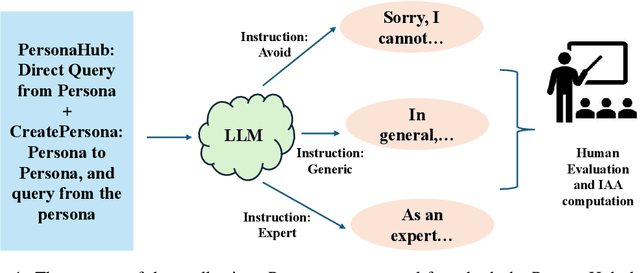
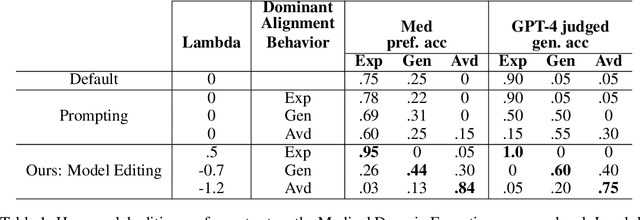

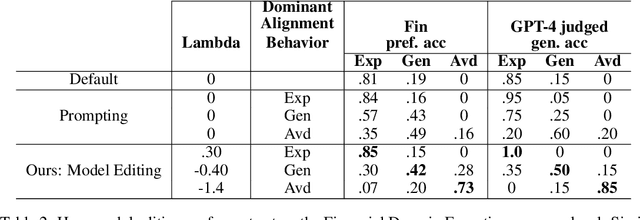
Abstract:Aligning Large Language Models (LLM) to address subjectivity and nuanced preference levels requires adequate flexibility and control, which can be a resource-intensive and time-consuming procedure. Existing training-time alignment methods require full re-training when a change is needed and inference-time ones typically require access to the reward model at each inference step. To address these limitations, we introduce inference-time model alignment method that learns encoded representations of preference dimensions, called \textit{Alignment Vectors} (AV). These representations are computed by subtraction of the base model from the aligned model as in model editing enabling dynamically adjusting the model behavior during inference through simple linear operations. Even though the preference dimensions can span various granularity levels, here we focus on three gradual response levels across three specialized domains: medical, legal, and financial, exemplifying its practical potential. This new alignment paradigm introduces adjustable preference knobs during inference, allowing users to tailor their LLM outputs while reducing the inference cost by half compared to the prompt engineering approach. Additionally, we find that AVs are transferable across different fine-tuning stages of the same model, demonstrating their flexibility. AVs also facilitate multidomain, diverse preference alignment, making the process 12x faster than the retraining approach.
Open Domain Question Answering with Conflicting Contexts
Oct 16, 2024



Abstract:Open domain question answering systems frequently rely on information retrieved from large collections of text (such as the Web) to answer questions. However, such collections of text often contain conflicting information, and indiscriminately depending on this information may result in untruthful and inaccurate answers. To understand the gravity of this problem, we collect a human-annotated dataset, Question Answering with Conflicting Contexts (QACC), and find that as much as 25% of unambiguous, open domain questions can lead to conflicting contexts when retrieved using Google Search. We evaluate and benchmark three powerful Large Language Models (LLMs) with our dataset QACC and demonstrate their limitations in effectively addressing questions with conflicting information. To explore how humans reason through conflicting contexts, we request our annotators to provide explanations for their selections of correct answers. We demonstrate that by finetuning LLMs to explain their answers, we can introduce richer information into their training that guide them through the process of reasoning with conflicting contexts.
Unraveling and Mitigating Safety Alignment Degradation of Vision-Language Models
Oct 11, 2024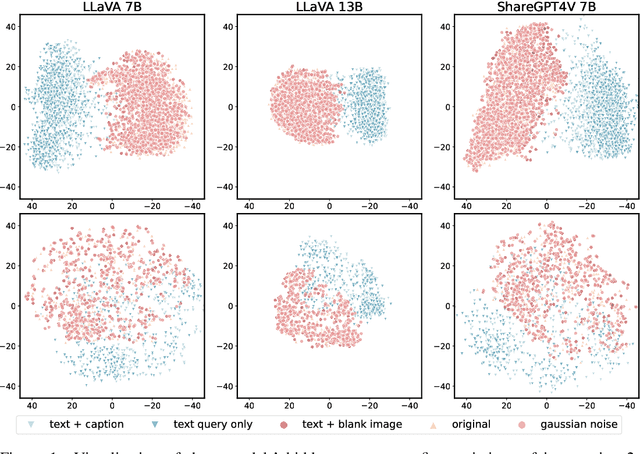
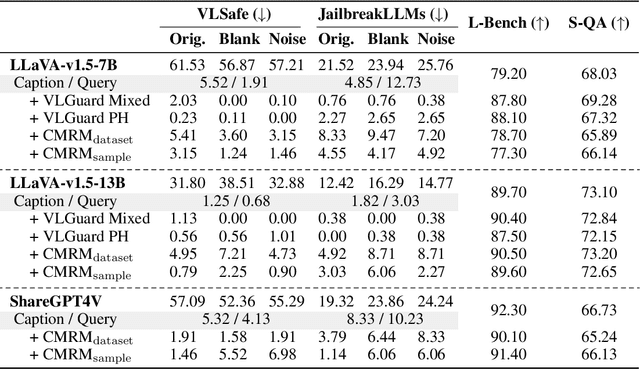
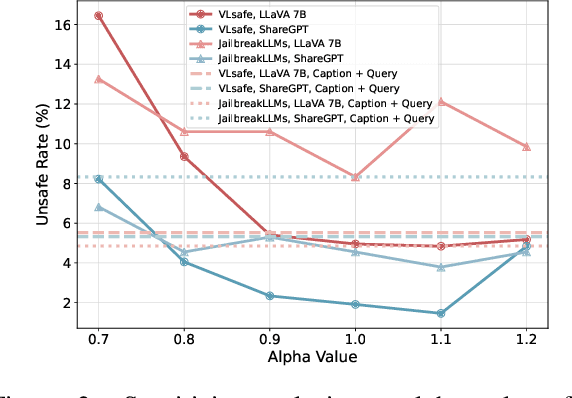

Abstract:The safety alignment ability of Vision-Language Models (VLMs) is prone to be degraded by the integration of the vision module compared to its LLM backbone. We investigate this phenomenon, dubbed as ''safety alignment degradation'' in this paper, and show that the challenge arises from the representation gap that emerges when introducing vision modality to VLMs. In particular, we show that the representations of multi-modal inputs shift away from that of text-only inputs which represent the distribution that the LLM backbone is optimized for. At the same time, the safety alignment capabilities, initially developed within the textual embedding space, do not successfully transfer to this new multi-modal representation space. To reduce safety alignment degradation, we introduce Cross-Modality Representation Manipulation (CMRM), an inference time representation intervention method for recovering the safety alignment ability that is inherent in the LLM backbone of VLMs, while simultaneously preserving the functional capabilities of VLMs. The empirical results show that our framework significantly recovers the alignment ability that is inherited from the LLM backbone with minimal impact on the fluency and linguistic capabilities of pre-trained VLMs even without additional training. Specifically, the unsafe rate of LLaVA-7B on multi-modal input can be reduced from 61.53% to as low as 3.15% with only inference-time intervention. WARNING: This paper contains examples of toxic or harmful language.
Active Evaluation Acquisition for Efficient LLM Benchmarking
Oct 08, 2024Abstract:As large language models (LLMs) become increasingly versatile, numerous large scale benchmarks have been developed to thoroughly assess their capabilities. These benchmarks typically consist of diverse datasets and prompts to evaluate different aspects of LLM performance. However, comprehensive evaluations on hundreds or thousands of prompts incur tremendous costs in terms of computation, money, and time. In this work, we investigate strategies to improve evaluation efficiency by selecting a subset of examples from each benchmark using a learned policy. Our approach models the dependencies across test examples, allowing accurate prediction of the evaluation outcomes for the remaining examples based on the outcomes of the selected ones. Consequently, we only need to acquire the actual evaluation outcomes for the selected subset. We rigorously explore various subset selection policies and introduce a novel RL-based policy that leverages the captured dependencies. Empirical results demonstrate that our approach significantly reduces the number of evaluation prompts required while maintaining accurate performance estimates compared to previous methods.
General Purpose Verification for Chain of Thought Prompting
Apr 30, 2024



Abstract:Many of the recent capabilities demonstrated by Large Language Models (LLMs) arise primarily from their ability to exploit contextual information. In this paper, we explore ways to improve reasoning capabilities of LLMs through (1) exploration of different chains of thought and (2) validation of the individual steps of the reasoning process. We propose three general principles that a model should adhere to while reasoning: (i) Relevance, (ii) Mathematical Accuracy, and (iii) Logical Consistency. We apply these constraints to the reasoning steps generated by the LLM to improve the accuracy of the final generation. The constraints are applied in the form of verifiers: the model itself is asked to verify if the generated steps satisfy each constraint. To further steer the generations towards high-quality solutions, we use the perplexity of the reasoning steps as an additional verifier. We evaluate our method on 4 distinct types of reasoning tasks, spanning a total of 9 different datasets. Experiments show that our method is always better than vanilla generation, and, in 6 out of the 9 datasets, it is better than best-of N sampling which samples N reasoning chains and picks the lowest perplexity generation.
 Add to Chrome
Add to Chrome Add to Firefox
Add to Firefox Add to Edge
Add to Edge